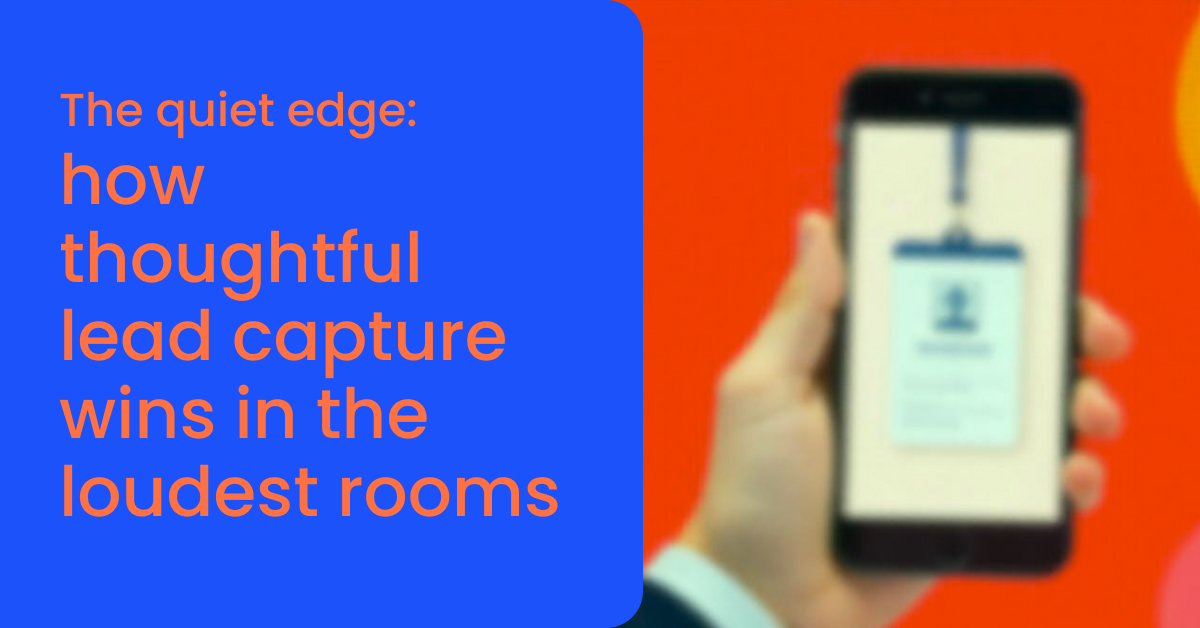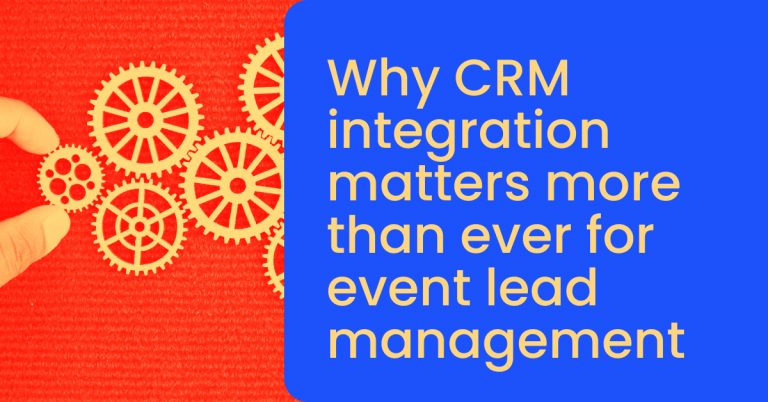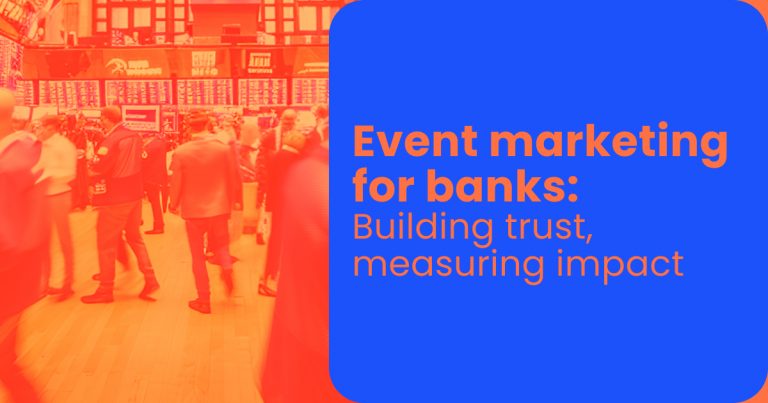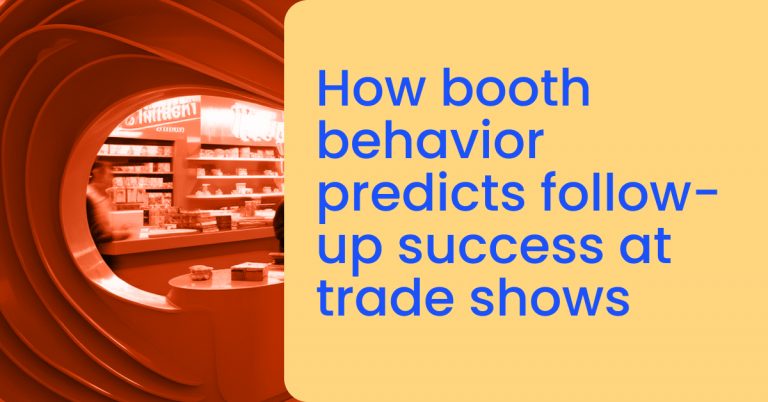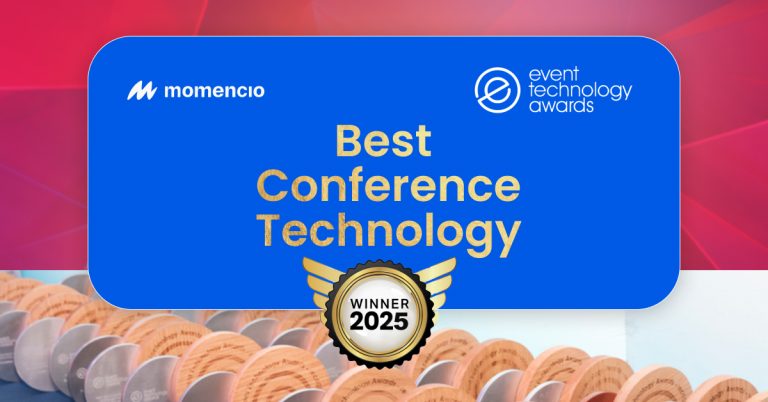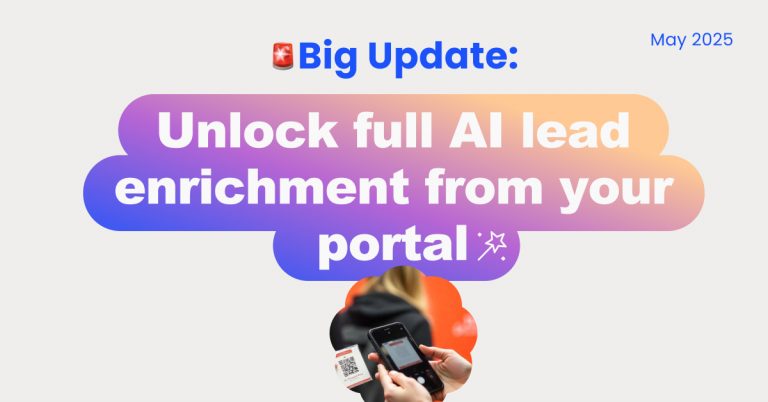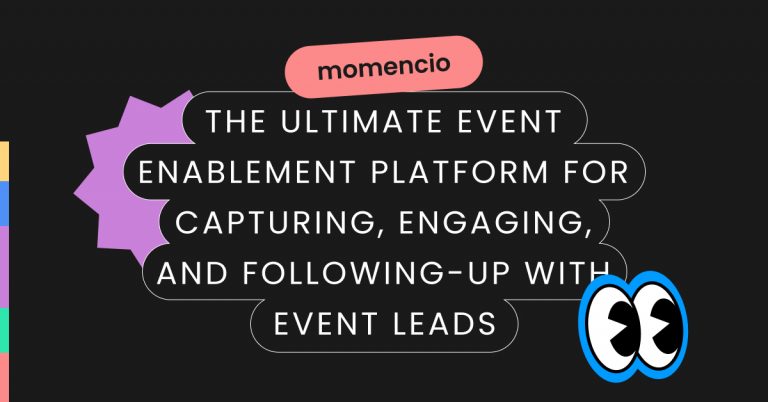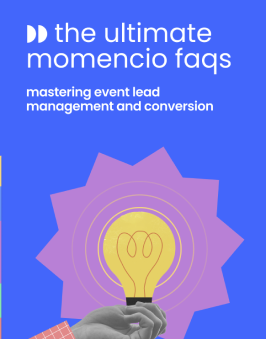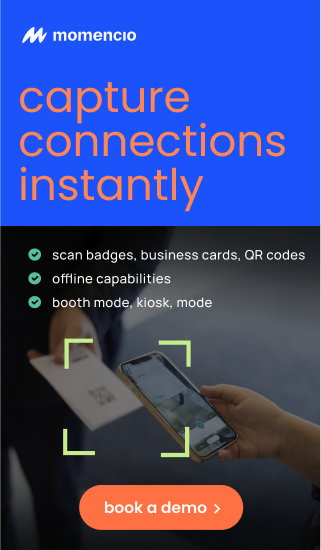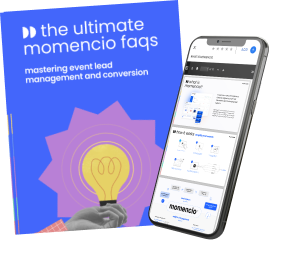Every booth is a spectacle. LED walls pulse with motion. Branded coffee carts compete with VR headsets. Crowds drift from one activation to the next, fueled by energy drinks and free tote bags. And somewhere in that storm, your team is expected to create connection, spark intent, and collect leads that will one day turn into revenue, where only thoughtful lead capture wins.
It’s no wonder so many companies walk away from events feeling exhausted but unsure of what they achieved.
The problem isn’t a lack of effort. It’s a lack of clarity. Too many teams mistake activity for effectiveness. They over-prepare their signage and under-prepare their system. They train for “what to say,” but not “what to track.” They scan badges with no follow-up plan. And afterward, they struggle to show what all the noise actually produced.
The organizations that succeed at events — truly succeed — operate differently. They don’t just show up. They build systems that scale clarity, not chaos.
They know what a good lead looks like before the first handshake. They capture data with intention. They follow up with speed and personalization. They close the loop between marketing, sales, and CRM. And they treat in-person events not as a one-time push — but as a continuous stream of signal and opportunity.
This is the quiet edge: the unseen discipline that turns your booth from a cost center into a growth engine.
This guide is your blueprint to getting there. Based on deep research and lived experience, it will walk you through the principles and systems that separate reactive event teams from proactive, high-converting ones. It’s not about flashy tech or trendy tactics. It’s about building the habits and frameworks that help you win — even in the noisiest rooms.
Let’s begin where all high-impact systems do: with intention.
Begin with the end in mind: The real cost of unclear event goals
“All things are created twice. First mentally, then physically.”
— Stephen R. Covey
Too often, companies walk into an event hoping something good will happen — that interest will magically turn into opportunity. That visibility will lead to conversion. That collecting more names will somehow mean more business.
But hope is not a strategy. And visibility is not value.
The first creation — the mental one — is missing. And without it, all the tactical execution that follows is unanchored. Banners are printed. Flights are booked. The booth is set up. But no one has taken the time to define what success looks like, how it will be measured, or what systems need to be in place to make it repeatable.
This is how smart teams end up with blurry outcomes.
The principle: Start with clarity, not motion
At the heart of every successful event program is a simple but powerful truth:
Clarity creates momentum. Confusion creates waste.
When you begin with a clear, shared vision of why you are showing up, whom you want to engage, and what actions you want to drive — every decision downstream becomes easier:
- The design of your booth becomes more purposeful.
- Your reps ask better questions.
- Your lead capture process is more intentional.
- Your follow-up is personalized, not generic.
- Your metrics tie back to outcomes, not activity.
But when this clarity is missing — when teams confuse energy with effectiveness — the costs begin to mount silently.
The hidden costs of unclear event goals
Let’s call them what they are: invisible drains on your marketing investment.
| Hidden cost | What it looks like |
| Scattered leads | Business cards in pockets. Notes on napkins. No central source of truth. |
| Slow follow-ups | Reps wait days to act. Leads go cold. Opportunities vanish. |
| Shallow qualification | Everyone is a “lead.” No one is prioritized. No one is converted. |
| Misaligned teams | Marketing collects. Sales complains. CRM becomes a junkyard. |
| Unmeasurable ROI | Leadership asks, “Was it worth it?” The answer is a shrug. |
| Repeating the cycle | Same mistakes. Same scramble. Different city. |
The question to ask before you step onto the show floor
Before your team even books a flight or scans a single badge, ask:
“What outcome are we designing this experience to create — and what systems are in place to support that outcome?”
That is the first creation. That is the quiet edge. And it begins in your war room — not your booth.
Sharpen the system: Why manual capture methods are failing you
In any discipline, your results will never exceed the quality of your system.
If your sales process after an event still depends on handwritten forms, Excel exports, or scattered CRM notes — it doesn’t matter how many people visited your booth. You’re building on sand.
You might be thinking, “But we’ve always done it this way.”
That’s precisely the point. Many companies are stuck operating with outdated tools — not because they lack effort, but because they haven’t taken the time to step back and sharpen the saw.
This is the principle:
Efficiency is doing things right. Effectiveness is doing the right things. Your capture process must be both.
Let’s compare the default approach with a disciplined, modern one.
Manual vs. momencio: A tale of two lead capture mindsets
| Principle | Manual capture mindset | momencio’s lead capture system |
| Clarity | Capture names, figure it out later | Define what qualifies as a good lead before you start |
| Speed | Data entered post-event, days later | Leads sync to CRM in real time at the booth |
| Data Quality | Illegible handwriting, missed info | Standardized forms, badge scans, enriched profiles |
| Engagement Insight | No idea what happened after the booth visit | Track what content was viewed, shared, downloaded |
| Sales Handoff | “Here’s a list of names” | “Here’s what they care about, and what they did” |
| Follow-Up | Delayed, generic, easily forgotten | Automated, timely, tailored to the interaction |
| Scalability | Breaks down with volume | Handles 50 or 5,000 leads with the same precision |
| Accountability | No audit trail, limited performance visibility | Full analytics dashboard — who followed up, when, how |
| Momentum | Leads go cold before reps even respond | Momentum continues through triggered sequences and microsites |
Seek first to understand: What your prospects are silently telling you through behavior
In the fast-moving environment of trade shows, most teams are trained to speak. Very few are trained to listen. Not with their ears — but with their systems.
When someone walks up to your booth, asks for a brochure, watches a demo, or clicks on a follow-up link… they are communicating intent. They are telling you where they’re in the journey, what matters to them, and how urgently they want to move forward.
The problem is, most companies have no structured way to capture or respond to these quiet signals. They hand out flyers and never know if they’re read. They email after the event with the same PDF — regardless of interest. They track names, but not curiosity.
If you want to truly serve your prospects — not just sell to them — you must observe before you pursue.
You must seek first to understand.
Checklist: Behavioral signals your prospects are already giving you for easy lead capture wins
✅ Did they open the follow-up email after the booth visit?
✅ Which links did they click — and which did they ignore?
✅ How long did they view the product presentation you shared?
✅ Did they explore the interactive microsite you sent after scanning their badge?
✅ Did they reshare any of the digital content you provided?
✅ Did they return to the booth the next day with specific questions?
✅ Did they engage with a particular solution or category over others?
✅ Were they more interested in pricing, use cases, or implementation details?
✅ Did they drop off midway through an asset or watch it to completion?
✅ Were they one of the first to follow up — or one of the quiet ones?
Each of these signals holds value. Together, they form a behavioral fingerprint — the honest, unspoken story of interest, intent, and readiness.
Most systems ignore it. momencio captures it.
Because when you know what your prospects are paying attention to, you know what your sales team should be saying next.
That’s not just data. That’s understanding.
Put first things first: Build a lead capture flow that serves sales, not just scans badges
Every event team talks about “capturing leads.”
But not every team is honest about what happens next. They celebrate how many badges were scanned. They high-five over booth traffic. But when the event ends and the real work begins, sales is left with a spreadsheet — and silence.
This is a symptom of misplaced priority. Too much emphasis on collection, too little on conversion.
Putting first things first means building a lead flow that mirrors your sales funnel — not your booth layout. It means designing a system where every scan leads somewhere specific. And it means prioritizing readiness over raw volume.
Let’s walk through that system.
From scan to system: The modern lead capture flow
Here’s what a high-functioning event lead capture workflow looks like, when designed with sales success in mind:
Step 1: Define the goal before the event
- What type of leads are we targeting?
- What qualifies as “sales-ready”?
- What outcomes do we want to report post-event?
Begin with the end in mind. Don’t just capture for the sake of capturing.
Step 2: Scan with structure, not just speed
- Use badge scan or QR capture via a lead capture tool like momencio
- Include real-time qualification questions (e.g., role, timeline, budget stage)
- Allow booth reps to tag intent or interest manually on the spot
Every scan should come with context. Without it, you’re building noise, not signal.
Step 3: Deliver value instantly
- Trigger a personalized email within minutes
- Include a digital microsite with relevant resources (product sheets, videos, use cases)
- Let the lead engage while still at the event — before they forget you
This is your second handshake. Make it count.
Step 4: Track engagement post-interaction
- See which content was viewed, clicked, reshared, or ignored
- Assign engagement scores based on behavior
- Surface top engaged leads in real time to sales teams
Behavior is the new business card. It tells you who’s moving, and who’s not.
Step 5: Sync everything to CRM automatically
- Push all leads — with tags, scores, and context — into Salesforce, HubSpot, etc.
- No Excel export. No formatting chaos. No delays.
- Leads are ready for action while your competitor is still typing
Your CRM is your truth. If it’s not in there cleanly, it’s not working.
Step 6: Automate follow-up workflows
- High-score leads = personal rep outreach within 24 hours
- Mid-score leads = targeted email drip campaign
- Low-score leads = soft nurture track, no pressure
Let automation do the remembering. Let your reps do the closing.
Step 7: Measure outcomes, not activity
- How many leads turned into meetings, opportunities, or deals?
- Which assets converted best?
- What ROI did the event generate compared to cost?
This is how you prove value. Not with foot traffic, but with funnel movement.
When you put first things first, you stop celebrating the number of scans — and start focusing on what each scan becomes.
That’s how you serve sales. That’s how you stop guessing. That’s how you grow.
Think pipeline, not pile-up: Turning events into revenue engines, not contact graveyards
There’s a moment after every trade show when the event team opens the lead report and breathes a sigh of relief.
“We got 642 scans.”
It feels like success.
But numbers without movement are just noise. And most of those 642 names — if captured without context, without follow-up, without insight — will go nowhere.
They’ll live in spreadsheets. They’ll get one email. They’ll never be heard from again. This is how events become contact graveyards. Not by intention — but by operating under myths that sound logical but quietly sabotage progress.
Let’s challenge those myths.
Think pipeline, not pile-up: The lead activation pyramid that turns contacts into revenue
Let’s face it: most event strategies are ladders leaning on the wrong wall.
They chase lead quantity, but never address readiness, relevance, or relationship.
That’s why, two weeks after a big event, inboxes are still quiet. Sales is frustrated. And the leadership team is asking: “What did we actually get out of that trade show?”
Here’s the truth most teams miss: Events aren’t a harvest. They’re a planting season. And unless you’ve designed a system for activation, your pipeline will stay dry — no matter how full your lead list looks.
Let’s make that real.
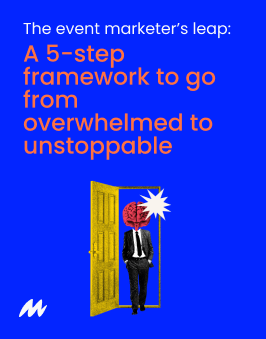
The lead activation pyramid
This simple framework explains why most leads collected at events never turn into deals — and what’s required to move them up.
Let’s break that down
Level 1: Raw lead capture (where most companies stop)
- This is where badge scans, form fills, and business cards live.
- It’s basic contact data — disconnected from interest or urgency.
- Most companies collect this… and do nothing structured with it.
- Outcome: a list. Not a lead.
The momencio difference:
Every scan is enriched with tags, interest markers, and behavioral breadcrumbs — starting clean, not cluttered.
Level 2: Intent signals stage (where most value is unlocked)
- This is where digital behavior begins to tell a story.
- Did they open the follow-up microsite? Watch the product video? Request a callback?
- This is the moment when curiosity becomes visible.
- Outcome: lead scoring, segmentation, prioritization.
The momencio difference:
Real-time engagement tracking connects lead actions to personalized content delivery — even while the event is still ongoing.
Level 3: Sales pipeline (where impact is measured)
- Leads that show intent are followed up — quickly, relevantly, and by the right team.
- These are leads that convert into meetings, deals, and revenue.
- Outcome: pipeline contribution that can be directly attributed to the event.
The momencio difference:
Automated workflows sync qualified leads directly into CRM with alerts, follow-up tasks, and behavioral context built in — so reps act fast, not blind.
Why this matters now
Events cost time, money, and people. But the return doesn’t come from the floor traffic — it comes from what you activate after the floor clears.
If your leads are stuck in level 1 — you don’t have a pipeline problem.
You have a pyramid problem.
And it’s one momencio was built to solve.
Synergize or stagnate: Event alignment between sales, marketing, and ops
You can have the best booth design, the smartest sales reps, and the most powerful lead capture system in the world — but if your internal teams aren’t aligned, the outcome will be friction, not flow.
True event success is not about individual excellence. It’s about cross-functional clarity. And clarity doesn’t happen by accident. Let’s assess yours.
The event alignment diagnostic scorecard
For each statement below, rate your team from 1 (never true) to 5 (always true). Then review the interpretation at the end.
Before the event
- We have a shared, documented definition of a “qualified lead” between sales and marketing.
- Sales, marketing, and event ops collaborate on booth goals and lead capture flow — not just logistics.
- Our CRM and event tech stack are fully integrated and tested before the event.
- Reps are briefed on messaging, capture strategy, and lead prioritization workflows.
- Marketing is clear on what data sales will actually use post-event.
During the event
- Booth staff log every interaction digitally and tag it for follow-up type or interest level.
- Sales leaders have real-time visibility into lead volume, engagement, and top interactions.
- Event marketing captures content engagement data (e.g., who watched what, clicked where).
- Everyone knows who is responsible for high-priority lead follow-up before the event ends.
- Cross-team decisions (e.g., shifting focus based on live signals) happen seamlessly.
After the event
- Leads flow into CRM with no manual data cleanup or delay.
- Sales follows up using intent signals, not just names and titles.
- Marketing runs targeted nurture based on event behaviors and tags.
- Leadership receives a report tying event investment to pipeline impact within 7 days.
- Learnings from the event are captured and applied to the next one.
Scoring interpretation
- 41–50: You’re operating like a revenue team, not a marketing team. Keep reinforcing the system.
- 31–40: Strong foundation, but minor misalignments may be creating friction. Tune the handoffs.
- 21–30: You’re working hard, but likely leaking pipeline due to miscommunication. Rethink the process.
- 11–20: Your team is likely siloed. Coordination gaps are costing you leads and revenue.
- 0–10: You’re not just misaligned — you’re working at odds. Time to redesign from the ground up.
momencio isn’t just a lead capture tool. It’s a shared source of truth across teams — syncing data, surfacing intent, and ensuring every handoff is supported by system logic, not verbal memory.
Because without synergy, you’re just collecting — not converting.
Be proactive, not reactive: Your post-event plan is your growth strategy
Trade shows and conferences don’t end when the booth comes down. That’s merely the end of visibility — not of opportunity. What happens in the thirty days that follow is what separates the event teams that generate long-term revenue from those that quietly fade into file folders and CRM clutter.
Most companies operate on a delayed reaction model. They collect leads, hand them over to sales, and hope for the best. The first emails go out late. The follow-ups are generic. No one’s sure who’s working which lead or whether they were even a fit to begin with. The days slip by, and with each one, the value of the event — and the warmth of the prospect — begins to decay.
The alternative is a proactive, time-bound system that treats every moment post-event as a window to accelerate trust, clarity, and conversion. It’s not just a plan — it’s a commitment to momentum. It’s where preparation meets execution.
Let’s look at how that system should operate when done right.
The disciplined post-event timeline
A well-structured post-event strategy runs on a clear timeline — not just for activity, but for intentional movement through the funnel. It begins while the event is still happening and continues long after the venue is empty.
Day 0: Capture and qualify in real-time
During the event, the goal is not just to gather data, but to add value while the interaction is still fresh. With a platform like momencio, this means scanning badges, enriching each lead with notes, tags, and qualifying inputs, and delivering tailored content on the spot — through personalized microsites, digital brochures, or targeted case studies. Every lead captured is immediately routed into a centralized system, already prepped for what comes next. You’re not logging information. You’re preparing for action.
Day 1: Organize, route, and personalize outreach
The morning after the event is when most teams stall — and when proactive teams surge ahead. With clean data already in place, your system should now automatically trigger personalized follow-ups based on interest areas, conversation tags, or content engagement from the booth. This is not a one-size-fits-all email blast. It’s a mapped response system where a prospect who engaged with a product demo receives a message relevant to that demo — and a meeting link from a rep who knows their name.
Day 3: Prioritize and assign ownership
Within 72 hours, human follow-up must begin. By now, your system has had time to identify high-interest signals — opened emails, clicked links, downloads, and return visits to microsites. These insights should guide your sales team to prioritize leads who are showing signs of active interest, not passive collection. Sales leadership should assign reps with clarity, backed by data, not guesswork. If a contact spent six minutes watching a demo video and requested pricing materials, they should not sit in a queue. They should already be in conversation.
Day 7: Begin structured follow-up tracks
A week after the event, the first conversion benchmarks should be visible. How many leads have entered sales conversations? How many have booked meetings? How many have dropped off completely? At this stage, your team should initiate differentiated nurture tracks — with high-interest leads moving into direct outreach and others placed into curated drip campaigns that match their indicated needs. The follow-up doesn’t just continue — it evolves based on behavior. With momencio, that evolution is driven by live engagement data.
Day 30: Report, reflect, and reinvest insight
After one month, the most important question becomes not how many leads you generated — but how many you activated. This is where most teams fall short. A reactive organization stops at the handoff. A proactive organization looks at every touchpoint: What behaviors correlated with conversion? What messaging resonated most? Which reps followed up promptly — and which didn’t? These insights become your roadmap for the next event. They aren’t just metrics. They’re momentum.
The real question is: who owns the post-event window?
In reactive teams, no one does. In proactive teams, everyone does — because the system makes it visible, repeatable, and real.
momencio was designed for this exact window. Not just to collect and store data — but to activate it while attention is still fresh and decision-making is still happening. That’s where the real ROI lives. And it’s why your post-event plan is not the end of the event… it’s the beginning of your growth strategy.
Conclusion: Your booth is not a billboard — it’s a starting line
The most successful teams don’t win trade shows by being the loudest, the flashiest, or the most dramatic. They win because they are present — not just physically, but strategically. They operate from principle, not panic.
They don’t confuse contact lists with connection. They don’t wait for leads to warm themselves. They don’t treat events as moments, but as systems.
Every scan has a reason. Every follow-up has a function. Every action serves a goal.
And when the booth lights shut off, their momentum doesn’t.
Because the goal was never the footfall. It was what followed. The goal was pipeline. Progress. Precision. Presence. In a world of noise, thoughtful lead capture is not just efficient — it’s transformative. It’s how your brand remembers and is remembered. It’s how you stop leaking opportunity and start leading outcomes.
And most importantly, it’s how you turn the chaos of in-person events into a calm, controlled, and measurable engine for long-term growth.
Ready to move from guessing to growing? Let’s build your next event system together.
If your events have felt chaotic, disconnected, or hard to measure, the solution isn’t working harder — it’s working with more intention. The most effective organizations don’t just show up at trade shows. They build systems that connect people to outcomes, content to behavior, and data to decisions.
That’s exactly what momencio was built for.
Whether you’re preparing for your first event of the year or looking to transform the way your team captures and activates leads, let’s design the system that finally puts your presence to work.
Your booth is ready. Now let’s make sure your pipeline is too. Book a free demo to see how momencio acts as your event intelligence solution.
FAQs
- What if our reps don’t want to use a new tool?
- Then it’s not just a tech issue — it’s a clarity issue. Most resistance comes when reps don’t see how the tool serves them. A platform like momencio reduces their manual follow-up work, shows them exactly who’s interested and why, and helps them close faster. When you connect adoption to advantage, behavior follows.
- Do digital leads really convert better than manually collected ones?
- Digital capture alone doesn’t guarantee better conversion. What does is what you do with the lead: the speed of follow-up, the relevance of messaging, and the clarity of behavioral data. momencio gives you all three — which is why users report not just more leads, but better ones moving faster through the funnel.
- Is this only worth it for big expos or flagship conferences?
- Not at all. In fact, smaller field events and recruitment drives benefit even more from clarity and automation — because every lead counts. The difference is not scale. The difference is control. And even with 50 leads, the cost of lost follow-up or poor data is still high. Systems scale both up and down.
- How fast is too fast to follow up after an event?
- There’s no such thing. In fact, leads contacted within five minutes are 21x more likely to convert. Timing signals relevance, attentiveness, and professionalism. With momencio, you can follow up while the conversation is still fresh — even while the event is ongoing. That’s not pushy. That’s present.
- What if our CRM isn’t set up properly yet?
- That’s not a blocker — that’s an opportunity to fix the foundation. Even without full CRM automation, momencio can organize, tag, and qualify your leads into a structured format that makes syncing easy later. Better to have clean, contextual data waiting — than a messy export you’ll never use.
Interesting facts from research
- 72% of exhibitors attend trade shows primarily for lead generation.
- Converting a trade show lead is 38% less expensive than relying solely on sales calls.
- 92% of event professionals plan to improve their post-event attendee follow-up strategies to maximize ROI.
